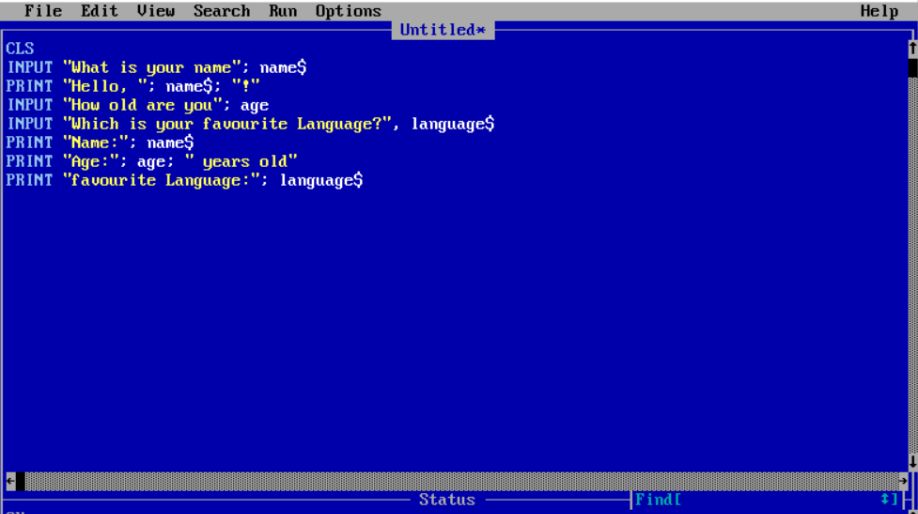Beginner%27s All Purpose Symbolic Instruction Code Tutorial
When I was 7, my mum enrolled my sister and me in a computer programming course (sister was 9 or had just turned 10). I was below the minimum age for the class, but I was also at that tag-along stage where I just go with my sister where she goes so mum has some hours to not be driving us somewhere, and can focus on her work, or having a summer (this was Lagos, where December is almost as hot as June, but work with me).
- Beginner's All Purpose Symbolic Instruction Code Tutorial For Beginners
- Beginner's All Purpose Symbolic Instruction Code Tutorial Python 3
QBASIC stands for “Quick Beginners All-Purpose Symbolic Instruction Code”.QBASIC was developed by Microsoft Corporation in the year 1991. It is considered to be one of the most easy-to-understand programming languages for beginners. QBasic stands for Quick Beginners All Purpose Symbolic Instruction Code. Quick Beginner All purpose Symbols and Interpreter Code. Quick Beginners All Purpose Symbols Instruction Code. N from the following: c. Quick Beginners All Purpose Symbolic Instruction Code. Quicker Beginner All Purposes Symbolic Instruction Code. Beginnings of BASIC. The language BASIC was an acronym for Beginner's All-Purpose Symbolic Instruction Code. It was developed by Dartmouth mathematicians John George Kemeny and Tom Kurtzas as a teaching tool for undergraduates. BASIC was intended to be a computer language for generalists to use to unlock the power of the computer in business and other realms of academia.
Well, so we learned a language called BASIC, Beginner’s All-Purpose Symbolic Instruction Code. I loved counting in tens, which I had to do for each line of code, and I loved forSkullgirls: color palette bundle for mac. statements and GO TO commands, and drawing flow diagrams, gosh did I love drawing flow diagrams! We had a class test and I remember scoring 7 or 7-and-a-half out of 10 and the teacher praising me to high heavens because everyone had assumed I had just come there to play Pacman and Prince of Persia and Space Invaders while I waited for my sister to learn stuff. Yet there I was, learning.
So that was my first experience with programming, well, besides playing around with some punch cards my dad had lying around the house for whatever reason. Fast forward to when I was 14 or 15, and my dad, who along with my mum likes to buy us all the best things, got us an iMac G3 for the house. The mini living room at the top of the stairs suddenly became the place to be in our house — whether to watch my sisters be Ryu and E. Honda at a very early version of Street Fighter, or to try my hands at yet another web site design using FrontPage. Our internet connection was still choppy at best, you’d literally read two pages of a novel while waiting for one light page to load. But it was the late 1990s and there was this beautiful new world of motion and interactivity, and beyond Solitaire and Microsoft Word’s Marching Ants text effect, we were a real part of it.

2001, I was taking a gap year at home before university. Our good family friend asked what I would like him to bring me from the States. At that specific time in history, Manolo Blahnik X Timberland heeled boots were new and in, and every Nigerian high-school girl wanted a pair. As did I. Yet I said I wanted a programming book. Let’s pause here to absorb the painful asceticism inherent in this decision. I had it in mind to study computer science at university, and I had been learning JavaScript at Aptech, a local computing school, but still. Disciplina pura y sencilla.
First year of University, I moved countries. I was also learning assembly language, which was the most beautiful thing I had ever seen. When I was 7, I had read in my sister’s France Afrique textbook, a short story of a girl who goes to Paris, and I had decided to myself then that I wanted to learn French, possibly with dreams of going to Paris. Learning a core computing language was like preparing to go to the Paris of computers; I just didn’t know then how long and fulfilling a journey I was embarking on.
Stands for 'Beginner's All-purpose Symbolic Instruction Code.' BASIC is a computer programming language that was developed in the mid-1960s to provide a way for students to write simple computer programs. Since then, the language has evolved into a more robust and powerful language and can be used to create advanced programs for today's computer systems.
BASIC originally used numbers at the beginning of each instruction (or line) to tell the computer what order to process the instructions. Lines would be numbered as 10, 20, 30, etc., which would allow additional instructions to be placed between commands later on if needed. 'GOTO' statements enabled programs to loop back to earlier instructions during execution. For example, line 230 of a BASIC program may have an 'if' clause that tells the computer to jump back to line 50 if a variable is less than 10. This instruction might look something like this:
Beginner's All Purpose Symbolic Instruction Code Tutorial For Beginners
230 IF (N < 10) THEN GOTO 50
Beginner's All Purpose Symbolic Instruction Code Tutorial Python 3
More modern BASIC implementations use 'while loops,' which perform a series of instructions as long as a certain case is true. Newer BASIC development software also supports more data types, such as integers, strings, and arrays, for storing variables and other data. While the first BASIC development environments were strictly text-based, today's BASIC programming software allows developers to design much of their programs visually, using a graphical user interface. Some of the more popular BASIC development programs used today include REALbasic and Microsoft Visual Basic.